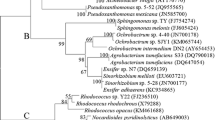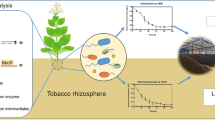Abstract
Two novel nicotine-degrading bacterial strains were isolated from tobacco waste and identified as Acinetobacter sp. TW and Sphingomonas sp. TY based on morphology, physiological and biochemical tests, Biolog analysis and 16S rDNA sequencing. The 16S rDNA sequences have been deposited in GenBank under the accession numbers FJ753401 for TW and FJ754274 for TY. The best culture conditions for nicotine degradation were 25–37°C and pH 7.0–8.0 for strain TW and 25–30°C and pH 6.0–7.0 for strain TY. Under the best conditions, the cell growth and nicotine-degradation kinetics of the two isolates were assessed, and 1.0 g/l nicotine was completely degraded within 12 and 18 h for TW and TY, respectively. Moreover, the presence of four widely-used commercial neonicotinoid insecticides in the medium had no effects on nicotine degradation by TW; among the four tested neonicotinoids, only thiamethoxam significantly delayed nicotine degradation by TY. TW and TY were also able to degrade selected neonicotinoids. This is the first report of nicotine degradation by Acinetobacter sp. and Sphingomonas sp. This study showed that these two newly isolated bacteria may be suitable for the disposal of tobacco waste and the reduction of nicotine in tobacco leaves.





Similar content being viewed by others
References
Adav S, Chen M, Lee D, Ren N (2007) Degradation of phenol by acinetobacter strain isolated from aerobic granules. Chemosphere 67:1566–1572
American Cancer Society (2005) Cancer facts and figures 2005. In: American Cancer Society, Atlanta, pp 40–45
Bi C, Zhao E, Liu Y, Qiu J, Zhou Z (2006) Direct optical resolution of chiral pesticides by HPLC on emamectin CSP under normal phase conditions. J Liq Chromatogr RT 29:1601–1607
Brandsch R (2006) Microbiology and biochemistry of nicotine degradation. Appl Microbiol Biot 69:493–498
Briški F, Horgas N, Vuković M, Gomzi Z (2003) Aerobic composting of tobacco industry solid waste-simulation of the process. Clean Technol Environ Policy 5:295–301
Buonaurio R, Stravato VM, Kosako Y, Fujiwara N, Naka T, Kobayashi K, Cappelli C, Yabuuchi E (2002) Sphingomonas melonis sp. Nov., a novel pathogen that causes brown spots on yellow Spanish melon fruits. Int J Syst Evol Micr 52:2081–2087
Chen CM, Li XM, Yang JK, Gong XW, Li B, Zhang KQ (2008) Isolation of nicotine-degrading bacterium Pseudomonas sp. Nic22, and its potential application in tobacco processing. Int Biodeter Biodegr 62:226–231
Civilini M, Domenis C, Sebastianutto N, de Berfoldi M (1997) Nicotine decontamination of tobacco agro-industrial waste and its degradation by micro-organisms. Waste Manag Res 15:349–358
Dai YJ, Ji WW, Chen T, Zhang WJ, Liu ZH, Ge F, Yuan S (2010a) Metabolism of the neonicotinoid insecticides acetamiprid and thiacloprid by the yeast Rhodotorula mucilaginosa strain IM-2. J Agr Food Chem 58:2419–2425
Dai YJ, Zhao YJ, Zhang WJ, Yu CG, Ji WW, Xu WP, Ni JP, Yuan S (2010b) Biotransformation of thianicotinyl neonicotinoid insecticides: diverse molecular substituents response to metabolism by bacterium stenotrophomonas maltophilia CGMCC 1.1788. Bioresour Technol 101:3838–3843
Decker K, Eberwein H, Gries FA, Brühmüller M (1961) Über den abbau des nicotins durch bakterienenzyme. IV. L-6-hydroxynicotine als erstes zwischenprodukt. Biochem Z 334:227–244
Dong X, Cai M (2001) Manual of systermatic determinative bacteriology. Science Press, Beijing
El Hajjouji H, Ait Baddi G, Yaacoubi A, Hamdi H, Winterton P, Revel JC, Hafidi M (2008) Optimisation of biodegradation conditions for the treatment of olive mill wastewater. Bioresour Technol 99:5505–5510
Fuentes-Contreras E, Basoalto E, Sandova C, Pavez P, Leal C, Burgos R, Munoz C (2007) Evaluation of efficacy, residual and knock down effects of pretransplant application of nicotinoid and nicotinoid-pyrethroid insecticide mixtures for the control of Myzus persicae nicotianae (Hemiptera: Aphididae) on tobacco. Agric Técnica 67:16–22
Ganas P, Sachelaru P, Mihasan S, Igloi GL, Brandsch R (2008) Two closely related pathways of nicotine catabolism in Arthrobacter nicotinovorans and Nocardioides sp. strain JS614. Arch Microbiol 189:511–517
Gong XW, Yang JK, Duan YQ, Dong JY, Zhe W, Wang L, Li QH, Zhang KQ (2009) Isolation and characterization of Rhodococcus sp. Y22 and its potential application to tobacco processing. Res Microbiol 160:200–204
Holt JG, Krieg NR, Sneath PHA (1994) Bergey’s manual of determinative bacteriology, 9th edn. Willims & Wilkins, Baltimore
Hung YJ, Peng CC, Tzen JT, Chen MJ, Liu JR (2008) Immobilization of neocallimastix patriciarum xylanase on artificial oil bodies and statistical optimization of enzyme activity. Bioresour Technol 99:8662–8666
Jeschke P, Nauen R (2008) Neonicotinoids-from zero to hero in insecticide chemistry. Pest Manag Sci 64:1084–1098
Kilbane II JJ, Daram A, Abbasian J, Kayser KJ (2002) Isolation and characterization of sphingomonas sp. GTIN11 capable of carbazole metabolism in petroleum. Biochem Bioph Res Commun 297:242–248
Koma D, Hasumi F, Yamamoto E, Ohta T, Chung S, Kubo M (2001) Biodegradation of long-chain n-paraffins from waste oil of car engine by acinetobacter sp. J Biosci Bioeng 91:94–96
Liu L, Zhao GH, Pang YN, Lei YZ, Gao JX, Liu MC (2010) Integrated biological and electrochemical oxidation treatment for high toxicity pesticide pollutant. Ind Eng Chem Res 49:5496–5503
Mace S, Mata-Alvarez JR (2002) Utilization of SBR technology for wastewater treatment: an overview. Ind Eng Chem Res 41:5539–5553
Meher KK, Panchwagh AM, Rangrass S, Gollakota KG (1995) Biomethanation of tobacco waste. Environ Pollut 2:199–202
Mohan C, Kumar Y, Madan J, Saxena N (2010) Multiresidue analysis of neonicotinoids by solid-phase extraction technique using high-performance liquid chromatography. Environ Monit Assess 165:573–576
Obana H, Okihashi M, Akutsu K, Kitagawa Y, Hori S (2002) Determination of acetamiprid, imidacloprid, and netenpyram residues in vegetables and fruits by high-performance liquid chromatography with diode-array detection. J Agr Food Chem 50:4464–4467
Reuveni M, Sheglov D (2002) Effects of azoxystrobin, difenoconazole, polyoxin B (polar) and trifloxystrobin on germination and growth of Alternaria alternate and decay in red delicious apple fruit. Crop Prot 21:951–955
Ruan AD, Min H, Peng XH, Huang Z (2005) Isolation and characterization of Pseudomonas sp. strain HF-1, capable of degrading nicotine. Res Microbiol 156:700–706
Schmit CG, Jahan K, Schmit KH, Debik E, Mahendraker V (2009) Activated sludge and other aerobic suspended culture processes. Water Environ Res 81:1127–1193
Shao TJ, Yang GQ, Wang MZ, Lu ZM, Min H, Zhao L (2010) Reduction of oxidative stress by bioaugmented strain Pseudomonas sp. HF-1 and selection of potential biomarkers in sequencing batch reactor treating tobacco wastewater. Ecotoxicology 19:1117–1123
Shen L, Liu Y, Xu HL (2010) Treatment of ampicillin-loaded wastewater by combined adsorption and biodegradation. J Chem Technol Biot 85:814–820
Sponza DT (2002) Toxicity studies in a tobacco industry biological treatment plant. Water Air Soil Poll 134:137–164
Sun KD, Zhu CJ, Zhong WH, Chen JM, Ye ZJ, Liu PJ, Zhou Q (2008) Isolation and characterization of a high nicotine-degrading bacterium, Pseudomonas sp. strain ZUTSKD. Acta Sci Circum 28:1294–1301
Tomizawa M, Casida JE (2003) Selective toxicity of neonicotinoids attributable to specificity of insect and mammalian nicotinic receptors. Annu Rev Entomol 48:339–364
Tomizawa M, Casida JE (2005) Neonicotinoid insecticide toxicology: mechanisms of selective action. Annu Rev Pharmacol Toxicol 45:247–268
Wang SN, Xu P, Tang HZ, Meng J, Liu XL, Huang J, Chen H, Du Y, Blankespoor HD (2004) Biodegradation and detoxification of nicotine in tobacco solid waste by a Pseudomonas sp. Biotechnol Lett 26:1493–1496
Wang MZ, Yang GQ, Min H, Lv ZM (2009a) A novel nicotine catabolic plasmid pMH1 in Pseudomonas sp. strain HF-1. Can J Microbiol 55:228–233
Wang MZ, Yang GQ, Min H, Lv ZM, Jia XY (2009b) Bioaugmentation with the nicotine-degrading bacterium Pseudomonas sp. HF-1 in a sequencing batch reactor treating tobacco wastewater: degradation study and analysis of its mechanisms. Water Res 43:4187–4196
Wang SN, Liu Z, Xu P (2009c) Biodegradation of nicotine by a newly isolated Agrobacterium sp. strain S33. J Appl Microbiol 107:838–847
Wilson K (1997) Preparation of genomic DNA from bacteria. In: Ausubel FM, Brent R, Kingston RE, Moore DD, Seidman JG, Smith JA, Struhl K (eds) Current protocols in molecular biology. Wiley, New York, pp 241–245
Yabuuchi E, Yano I, Oyaizu H, Hashimoto Y, Ezaki T, Yamamoto H (1990) Proposal of Sphingomonas paucimobilis gen. nov. and comb. nov., Sphingomonas parapaucimobilis sp. nov., Sphingomonas yanoikuyae sp. nov., Sphingomonas adhaesiva sp. nov., Sphingomonas capsulate comb. nov., and two genospecies of the genus Sphingomonas. Microbiol Immunol 34:99–119
Ye D, Siddiqi MA, Maccubbin AE, Kumar S, Sikka HC (1996) Degradation of polynuclear aromatic hydrocarbons by sphingomonas paucimobilis. Environ Sci Technol 30:136–142
Yus Azila Y, Mashitah MD, Bhatia S (2008) Process optimization studies of lead (Pb(II)) biosorption onto immobilized cells of Pycnoporus sanguineus using response surface methodology. Bioresour Technol 99:8549–8552
Acknowledgments
This work was financially supported by the National Key Science and Technology Project: Water Pollution Control and Treatment (No.2008ZX07101-006), 863 High Technology Program (No. 2007AA10Z409), Innovative Research Team in Higher Educational Institutions of Zhejiang Province (T200912) and Open Fund of Key Lab of Environmental Pollution Control Technology in Zhejiang Province.
Author information
Authors and Affiliations
Corresponding authors
Rights and permissions
About this article
Cite this article
Wang, M., Yang, G., Wang, X. et al. Nicotine degradation by two novel bacterial isolates of Acinetobacter sp. TW and Sphingomonas sp. TY and their responses in the presence of neonicotinoid insecticides. World J Microbiol Biotechnol 27, 1633–1640 (2011). https://doi.org/10.1007/s11274-010-0617-y
Received:
Accepted:
Published:
Issue Date:
DOI: https://doi.org/10.1007/s11274-010-0617-y




